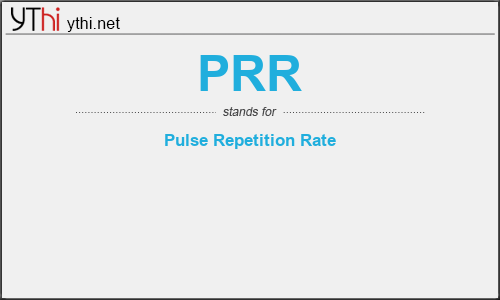What does PRR mean? What is the full form of PRR?
The Full Form of PRR is Pulse Repetition Rate.
The pulse repetition rate (or pulse repetition frequency) frep of a regular train of pulses is defined as the number of emitted pulses per second, or more precisely the inverse temporal pulse spacing.
Depending on the technique of pulse generation, typical pulse repetition rates can be in different parameter regions:
- Typical mode-locked solid-state lasers emit with pulse repetition rates between 50 MHz and a few gigahertz, but in extreme cases < 10 MHz or > 100 GHz are possible. In most cases, there is a single pulse circulating in such a laser, so that the pulse repetition rate is the inverse round-prep time in the laser resonator.
- Q switching of solid-state lasers typically allows repetition rates from below 1 Hz to the order of 100 kHz. For active Q switching, the pulse repetition rate is determined by an external drive signal, while for passive Q switching its depends on the magnitude of loss modulation, the pump power and various other parameters.
- Gain switching of semiconductor lasers can provide repetition rates from below 1 Hz to many megahertz.
- Attosecond pulse trains of finite length can be generated via high harmonic generation with repetition rates of hundreds of terahertz. Here, the pulse repetition rate is twice the optical frequency of the pump light.
If a pulse train is regular and the pulses are mutually coherent, the optical spectrum of the pulse train is a frequency comb, where the spacing of the lines is determined by the pulse repetition rate.
The deviation from perfect periodicity of the optical power is called timing jitter.
PRR
means
Pulse Repetition Rate![]()
Translate Pulse Repetition Rate to other language.
Select another language: Go
Do you want to know What does PRR mean? What is the full form of PRR?. Are you looking for What does PRR mean? What is the full form of PRR? What is PRR stand for? On this page, We talk about the various possible acronym, abbreviation, full form or slang term of PRR. The Full Form of PRR is Pulse Repetition Rate
You also might want to know: how to pronounce PRR,
how to pronounce Pulse Repetition Rate,
Still can't find the acronym definition for PRR? Please use our site search to look for more acronyms.
Showing the full form of PRR: 'Pulse Repetition Rate' on your site.


Leave a Reply
You must be logged in to post a comment.